Economic Analysis: Macro/Micro, Monetary & Fiscal Policy in Business
VerifiedAdded on 2023/06/10
|10
|2615
|364
Essay
AI Summary
This essay provides a comprehensive overview of key economic concepts relevant to business. It begins by differentiating between macroeconomics and microeconomics, illustrating their relationship with examples. The essay then examines the effectiveness of monetary and fiscal policies under both fixed and floating exchange rates, outlining how exchange rates are affected by various economic factors. Furthermore, it delves into the reasons behind firm growth, describing different types of growth strategies and their impact on profit maximization. Finally, the essay discusses domestic economic policies that governments can pursue to reduce or offset the costs associated with globalization and migration. Desklib offers a wide range of resources, including past papers and solved assignments, to support students in their academic endeavors.
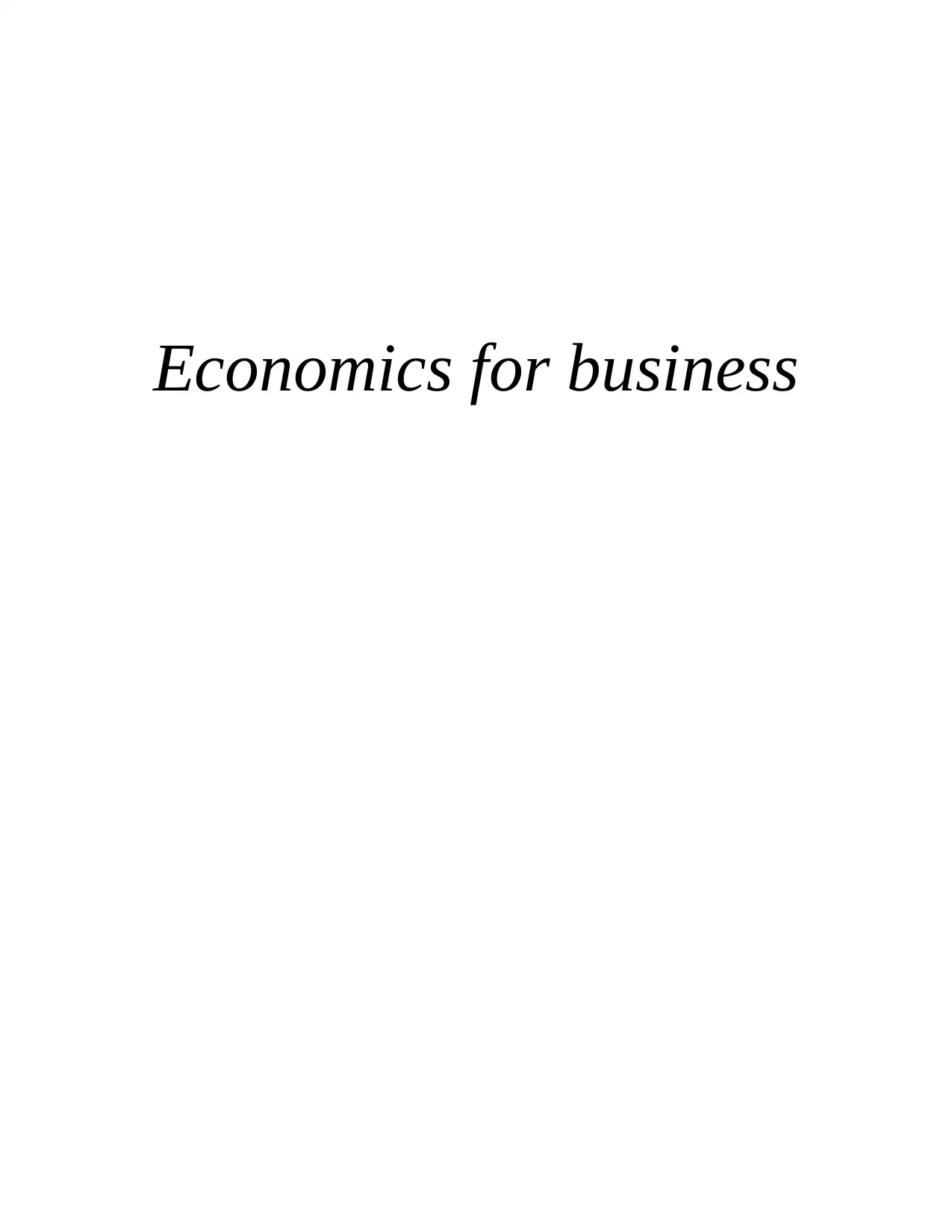
Economics for business
Paraphrase This Document
Need a fresh take? Get an instant paraphrase of this document with our AI Paraphraser
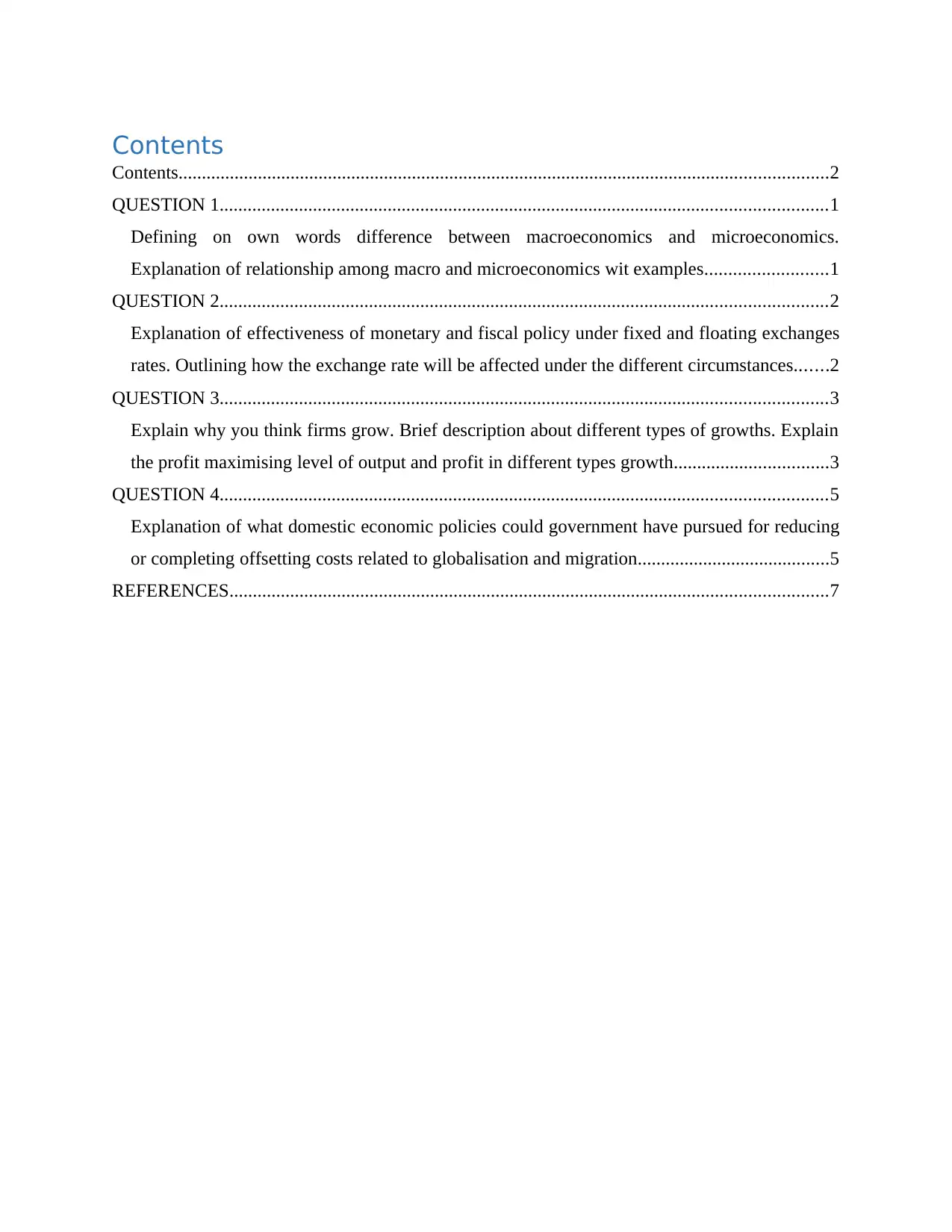
Contents
Contents...........................................................................................................................................2
QUESTION 1..................................................................................................................................1
Defining on own words difference between macroeconomics and microeconomics.
Explanation of relationship among macro and microeconomics wit examples..........................1
QUESTION 2..................................................................................................................................2
Explanation of effectiveness of monetary and fiscal policy under fixed and floating exchanges
rates. Outlining how the exchange rate will be affected under the different circumstances.......2
QUESTION 3..................................................................................................................................3
Explain why you think firms grow. Brief description about different types of growths. Explain
the profit maximising level of output and profit in different types growth.................................3
QUESTION 4..................................................................................................................................5
Explanation of what domestic economic policies could government have pursued for reducing
or completing offsetting costs related to globalisation and migration.........................................5
REFERENCES................................................................................................................................7
Contents...........................................................................................................................................2
QUESTION 1..................................................................................................................................1
Defining on own words difference between macroeconomics and microeconomics.
Explanation of relationship among macro and microeconomics wit examples..........................1
QUESTION 2..................................................................................................................................2
Explanation of effectiveness of monetary and fiscal policy under fixed and floating exchanges
rates. Outlining how the exchange rate will be affected under the different circumstances.......2
QUESTION 3..................................................................................................................................3
Explain why you think firms grow. Brief description about different types of growths. Explain
the profit maximising level of output and profit in different types growth.................................3
QUESTION 4..................................................................................................................................5
Explanation of what domestic economic policies could government have pursued for reducing
or completing offsetting costs related to globalisation and migration.........................................5
REFERENCES................................................................................................................................7

⊘ This is a preview!⊘
Do you want full access?
Subscribe today to unlock all pages.

Trusted by 1+ million students worldwide
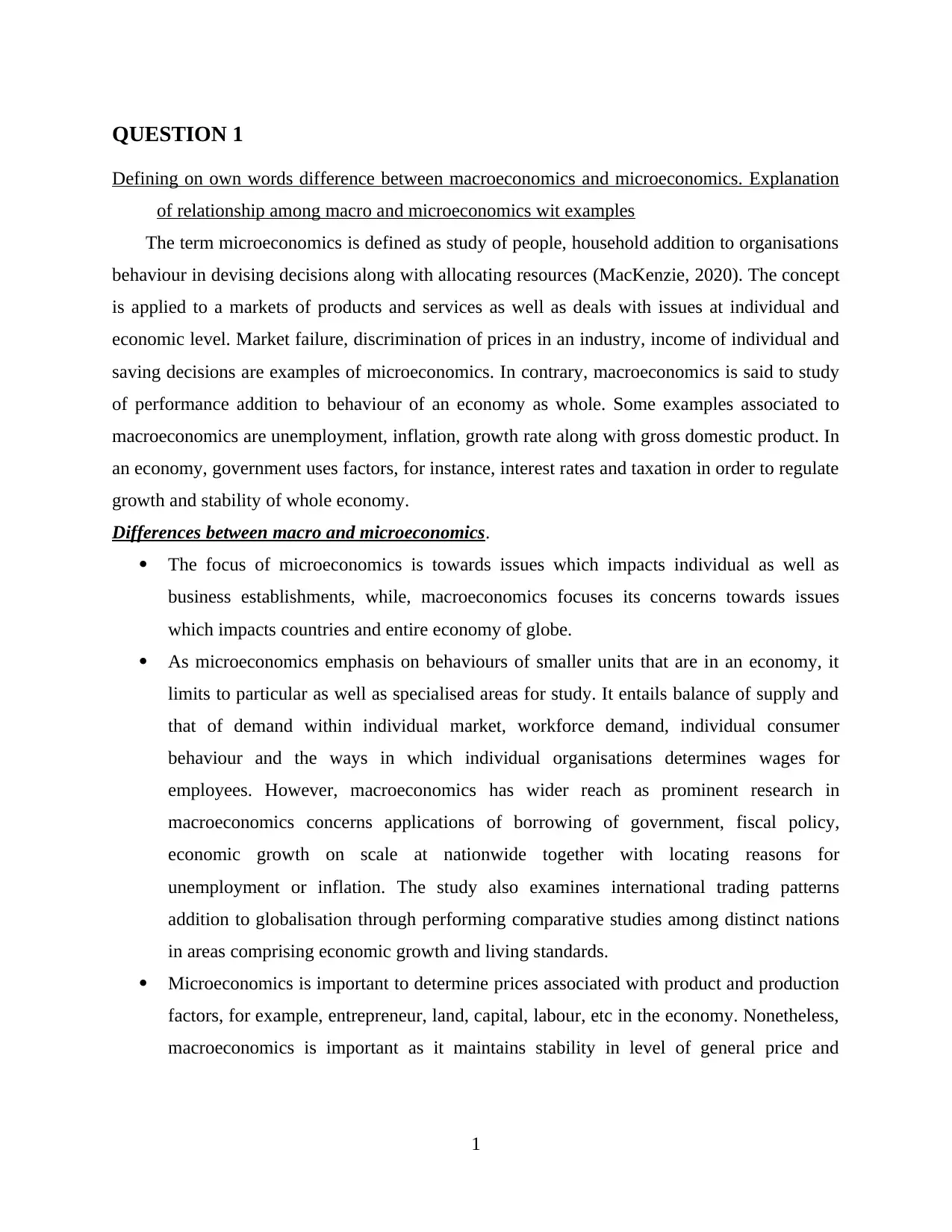
QUESTION 1
Defining on own words difference between macroeconomics and microeconomics. Explanation
of relationship among macro and microeconomics wit examples
The term microeconomics is defined as study of people, household addition to organisations
behaviour in devising decisions along with allocating resources (MacKenzie, 2020). The concept
is applied to a markets of products and services as well as deals with issues at individual and
economic level. Market failure, discrimination of prices in an industry, income of individual and
saving decisions are examples of microeconomics. In contrary, macroeconomics is said to study
of performance addition to behaviour of an economy as whole. Some examples associated to
macroeconomics are unemployment, inflation, growth rate along with gross domestic product. In
an economy, government uses factors, for instance, interest rates and taxation in order to regulate
growth and stability of whole economy.
Differences between macro and microeconomics.
The focus of microeconomics is towards issues which impacts individual as well as
business establishments, while, macroeconomics focuses its concerns towards issues
which impacts countries and entire economy of globe.
As microeconomics emphasis on behaviours of smaller units that are in an economy, it
limits to particular as well as specialised areas for study. It entails balance of supply and
that of demand within individual market, workforce demand, individual consumer
behaviour and the ways in which individual organisations determines wages for
employees. However, macroeconomics has wider reach as prominent research in
macroeconomics concerns applications of borrowing of government, fiscal policy,
economic growth on scale at nationwide together with locating reasons for
unemployment or inflation. The study also examines international trading patterns
addition to globalisation through performing comparative studies among distinct nations
in areas comprising economic growth and living standards.
Microeconomics is important to determine prices associated with product and production
factors, for example, entrepreneur, land, capital, labour, etc in the economy. Nonetheless,
macroeconomics is important as it maintains stability in level of general price and
1
Defining on own words difference between macroeconomics and microeconomics. Explanation
of relationship among macro and microeconomics wit examples
The term microeconomics is defined as study of people, household addition to organisations
behaviour in devising decisions along with allocating resources (MacKenzie, 2020). The concept
is applied to a markets of products and services as well as deals with issues at individual and
economic level. Market failure, discrimination of prices in an industry, income of individual and
saving decisions are examples of microeconomics. In contrary, macroeconomics is said to study
of performance addition to behaviour of an economy as whole. Some examples associated to
macroeconomics are unemployment, inflation, growth rate along with gross domestic product. In
an economy, government uses factors, for instance, interest rates and taxation in order to regulate
growth and stability of whole economy.
Differences between macro and microeconomics.
The focus of microeconomics is towards issues which impacts individual as well as
business establishments, while, macroeconomics focuses its concerns towards issues
which impacts countries and entire economy of globe.
As microeconomics emphasis on behaviours of smaller units that are in an economy, it
limits to particular as well as specialised areas for study. It entails balance of supply and
that of demand within individual market, workforce demand, individual consumer
behaviour and the ways in which individual organisations determines wages for
employees. However, macroeconomics has wider reach as prominent research in
macroeconomics concerns applications of borrowing of government, fiscal policy,
economic growth on scale at nationwide together with locating reasons for
unemployment or inflation. The study also examines international trading patterns
addition to globalisation through performing comparative studies among distinct nations
in areas comprising economic growth and living standards.
Microeconomics is important to determine prices associated with product and production
factors, for example, entrepreneur, land, capital, labour, etc in the economy. Nonetheless,
macroeconomics is important as it maintains stability in level of general price and
1
Paraphrase This Document
Need a fresh take? Get an instant paraphrase of this document with our AI Paraphraser
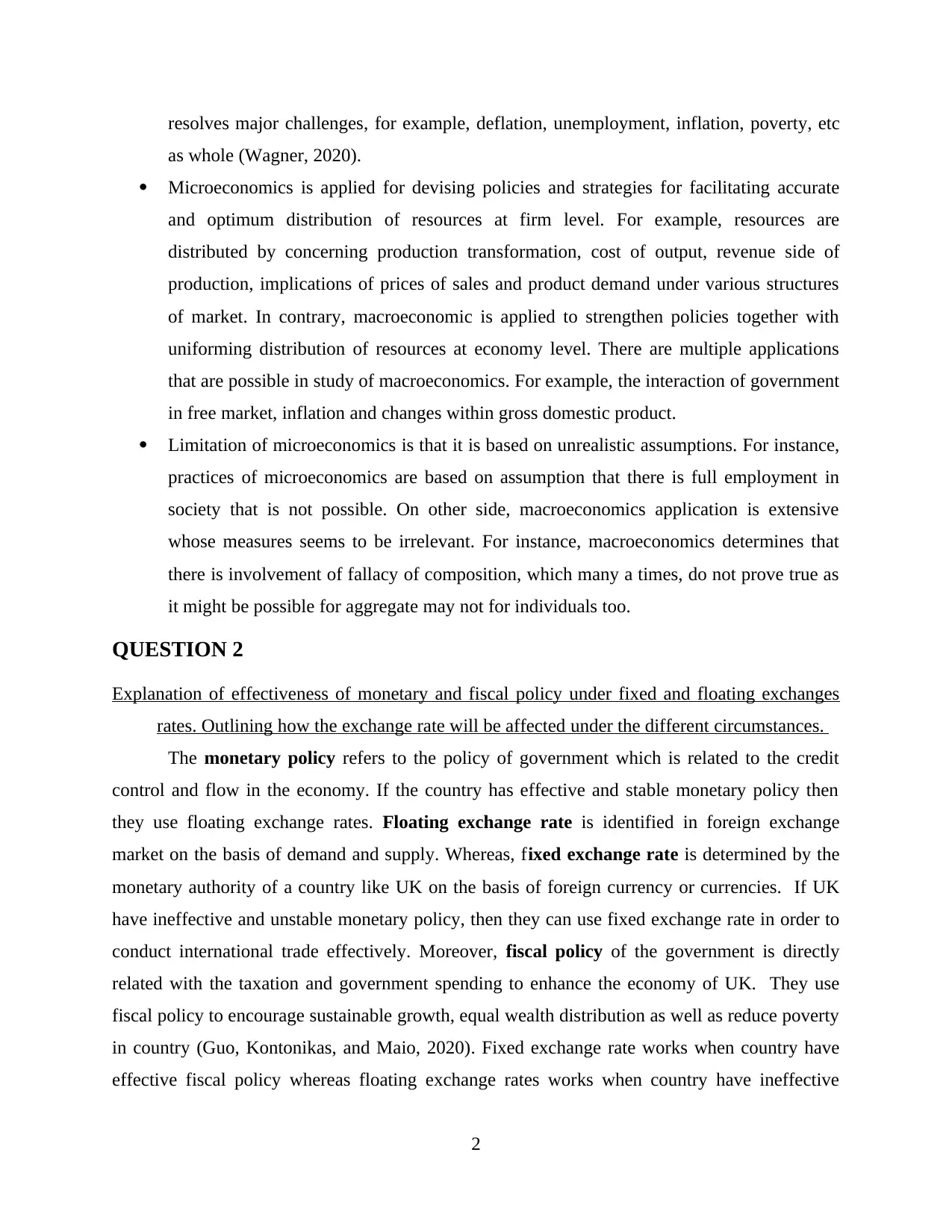
resolves major challenges, for example, deflation, unemployment, inflation, poverty, etc
as whole (Wagner, 2020).
Microeconomics is applied for devising policies and strategies for facilitating accurate
and optimum distribution of resources at firm level. For example, resources are
distributed by concerning production transformation, cost of output, revenue side of
production, implications of prices of sales and product demand under various structures
of market. In contrary, macroeconomic is applied to strengthen policies together with
uniforming distribution of resources at economy level. There are multiple applications
that are possible in study of macroeconomics. For example, the interaction of government
in free market, inflation and changes within gross domestic product.
Limitation of microeconomics is that it is based on unrealistic assumptions. For instance,
practices of microeconomics are based on assumption that there is full employment in
society that is not possible. On other side, macroeconomics application is extensive
whose measures seems to be irrelevant. For instance, macroeconomics determines that
there is involvement of fallacy of composition, which many a times, do not prove true as
it might be possible for aggregate may not for individuals too.
QUESTION 2
Explanation of effectiveness of monetary and fiscal policy under fixed and floating exchanges
rates. Outlining how the exchange rate will be affected under the different circumstances.
The monetary policy refers to the policy of government which is related to the credit
control and flow in the economy. If the country has effective and stable monetary policy then
they use floating exchange rates. Floating exchange rate is identified in foreign exchange
market on the basis of demand and supply. Whereas, fixed exchange rate is determined by the
monetary authority of a country like UK on the basis of foreign currency or currencies. If UK
have ineffective and unstable monetary policy, then they can use fixed exchange rate in order to
conduct international trade effectively. Moreover, fiscal policy of the government is directly
related with the taxation and government spending to enhance the economy of UK. They use
fiscal policy to encourage sustainable growth, equal wealth distribution as well as reduce poverty
in country (Guo, Kontonikas, and Maio, 2020). Fixed exchange rate works when country have
effective fiscal policy whereas floating exchange rates works when country have ineffective
2
as whole (Wagner, 2020).
Microeconomics is applied for devising policies and strategies for facilitating accurate
and optimum distribution of resources at firm level. For example, resources are
distributed by concerning production transformation, cost of output, revenue side of
production, implications of prices of sales and product demand under various structures
of market. In contrary, macroeconomic is applied to strengthen policies together with
uniforming distribution of resources at economy level. There are multiple applications
that are possible in study of macroeconomics. For example, the interaction of government
in free market, inflation and changes within gross domestic product.
Limitation of microeconomics is that it is based on unrealistic assumptions. For instance,
practices of microeconomics are based on assumption that there is full employment in
society that is not possible. On other side, macroeconomics application is extensive
whose measures seems to be irrelevant. For instance, macroeconomics determines that
there is involvement of fallacy of composition, which many a times, do not prove true as
it might be possible for aggregate may not for individuals too.
QUESTION 2
Explanation of effectiveness of monetary and fiscal policy under fixed and floating exchanges
rates. Outlining how the exchange rate will be affected under the different circumstances.
The monetary policy refers to the policy of government which is related to the credit
control and flow in the economy. If the country has effective and stable monetary policy then
they use floating exchange rates. Floating exchange rate is identified in foreign exchange
market on the basis of demand and supply. Whereas, fixed exchange rate is determined by the
monetary authority of a country like UK on the basis of foreign currency or currencies. If UK
have ineffective and unstable monetary policy, then they can use fixed exchange rate in order to
conduct international trade effectively. Moreover, fiscal policy of the government is directly
related with the taxation and government spending to enhance the economy of UK. They use
fiscal policy to encourage sustainable growth, equal wealth distribution as well as reduce poverty
in country (Guo, Kontonikas, and Maio, 2020). Fixed exchange rate works when country have
effective fiscal policy whereas floating exchange rates works when country have ineffective
2
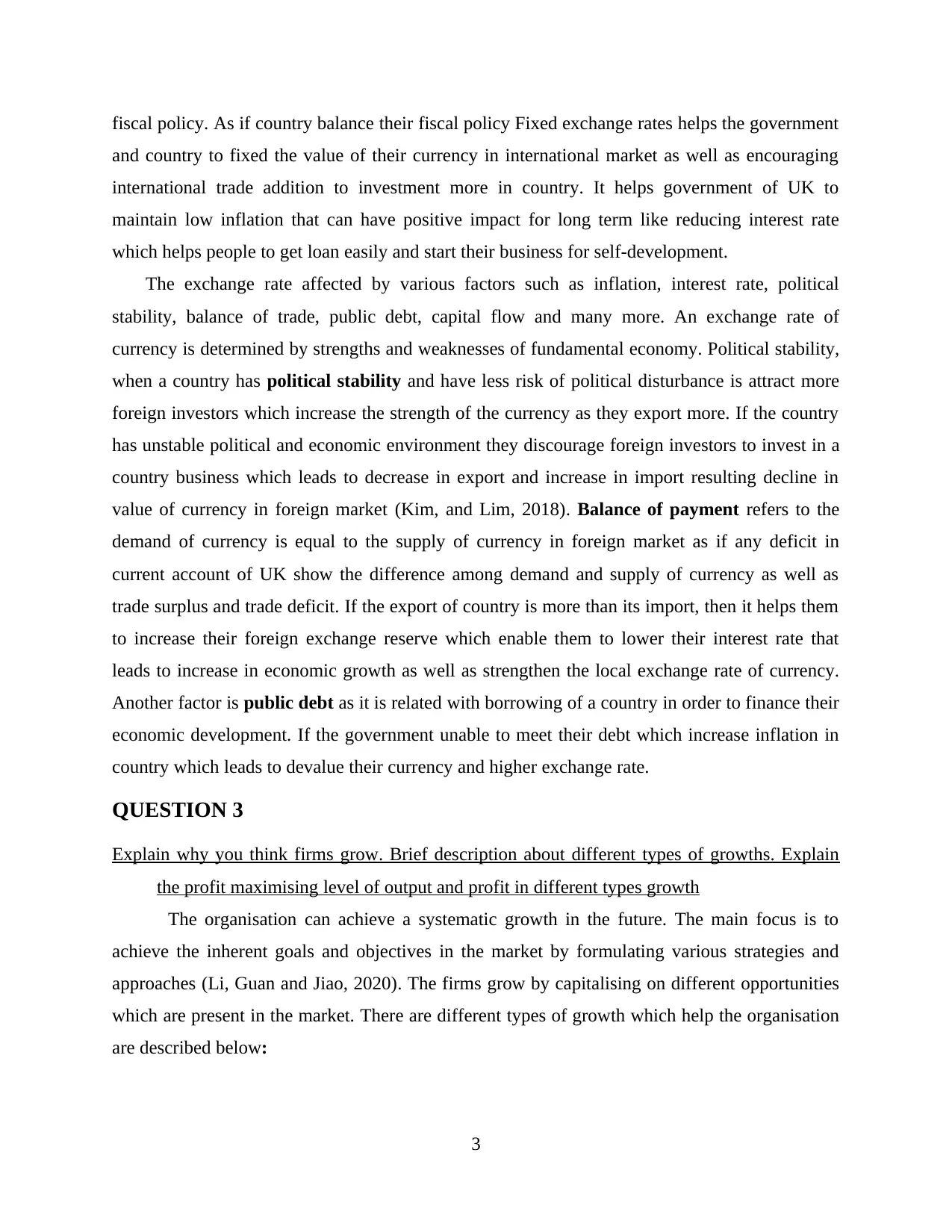
fiscal policy. As if country balance their fiscal policy Fixed exchange rates helps the government
and country to fixed the value of their currency in international market as well as encouraging
international trade addition to investment more in country. It helps government of UK to
maintain low inflation that can have positive impact for long term like reducing interest rate
which helps people to get loan easily and start their business for self-development.
The exchange rate affected by various factors such as inflation, interest rate, political
stability, balance of trade, public debt, capital flow and many more. An exchange rate of
currency is determined by strengths and weaknesses of fundamental economy. Political stability,
when a country has political stability and have less risk of political disturbance is attract more
foreign investors which increase the strength of the currency as they export more. If the country
has unstable political and economic environment they discourage foreign investors to invest in a
country business which leads to decrease in export and increase in import resulting decline in
value of currency in foreign market (Kim, and Lim, 2018). Balance of payment refers to the
demand of currency is equal to the supply of currency in foreign market as if any deficit in
current account of UK show the difference among demand and supply of currency as well as
trade surplus and trade deficit. If the export of country is more than its import, then it helps them
to increase their foreign exchange reserve which enable them to lower their interest rate that
leads to increase in economic growth as well as strengthen the local exchange rate of currency.
Another factor is public debt as it is related with borrowing of a country in order to finance their
economic development. If the government unable to meet their debt which increase inflation in
country which leads to devalue their currency and higher exchange rate.
QUESTION 3
Explain why you think firms grow. Brief description about different types of growths. Explain
the profit maximising level of output and profit in different types growth
The organisation can achieve a systematic growth in the future. The main focus is to
achieve the inherent goals and objectives in the market by formulating various strategies and
approaches (Li, Guan and Jiao, 2020). The firms grow by capitalising on different opportunities
which are present in the market. There are different types of growth which help the organisation
are described below:
3
and country to fixed the value of their currency in international market as well as encouraging
international trade addition to investment more in country. It helps government of UK to
maintain low inflation that can have positive impact for long term like reducing interest rate
which helps people to get loan easily and start their business for self-development.
The exchange rate affected by various factors such as inflation, interest rate, political
stability, balance of trade, public debt, capital flow and many more. An exchange rate of
currency is determined by strengths and weaknesses of fundamental economy. Political stability,
when a country has political stability and have less risk of political disturbance is attract more
foreign investors which increase the strength of the currency as they export more. If the country
has unstable political and economic environment they discourage foreign investors to invest in a
country business which leads to decrease in export and increase in import resulting decline in
value of currency in foreign market (Kim, and Lim, 2018). Balance of payment refers to the
demand of currency is equal to the supply of currency in foreign market as if any deficit in
current account of UK show the difference among demand and supply of currency as well as
trade surplus and trade deficit. If the export of country is more than its import, then it helps them
to increase their foreign exchange reserve which enable them to lower their interest rate that
leads to increase in economic growth as well as strengthen the local exchange rate of currency.
Another factor is public debt as it is related with borrowing of a country in order to finance their
economic development. If the government unable to meet their debt which increase inflation in
country which leads to devalue their currency and higher exchange rate.
QUESTION 3
Explain why you think firms grow. Brief description about different types of growths. Explain
the profit maximising level of output and profit in different types growth
The organisation can achieve a systematic growth in the future. The main focus is to
achieve the inherent goals and objectives in the market by formulating various strategies and
approaches (Li, Guan and Jiao, 2020). The firms grow by capitalising on different opportunities
which are present in the market. There are different types of growth which help the organisation
are described below:
3
⊘ This is a preview!⊘
Do you want full access?
Subscribe today to unlock all pages.

Trusted by 1+ million students worldwide
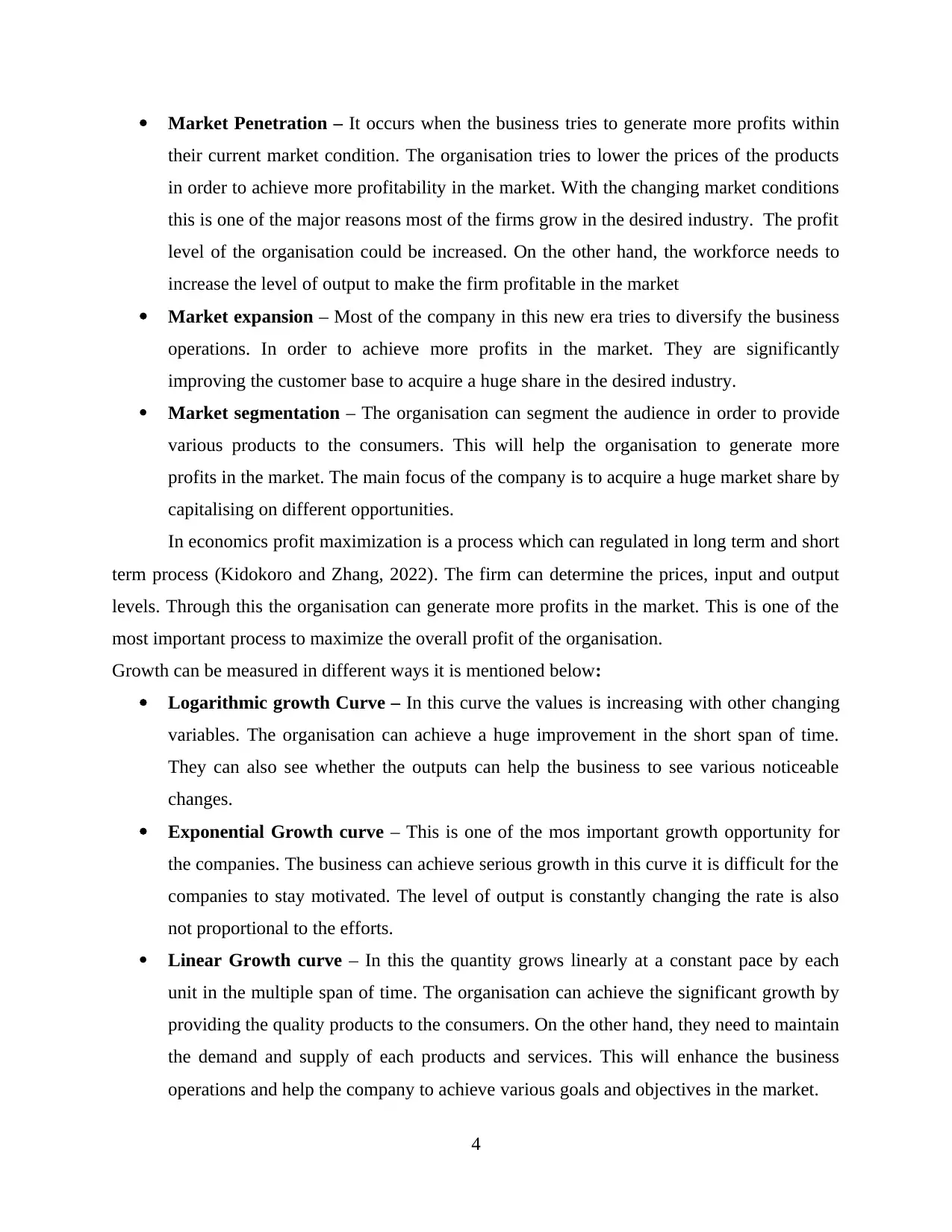
Market Penetration – It occurs when the business tries to generate more profits within
their current market condition. The organisation tries to lower the prices of the products
in order to achieve more profitability in the market. With the changing market conditions
this is one of the major reasons most of the firms grow in the desired industry. The profit
level of the organisation could be increased. On the other hand, the workforce needs to
increase the level of output to make the firm profitable in the market
Market expansion – Most of the company in this new era tries to diversify the business
operations. In order to achieve more profits in the market. They are significantly
improving the customer base to acquire a huge share in the desired industry.
Market segmentation – The organisation can segment the audience in order to provide
various products to the consumers. This will help the organisation to generate more
profits in the market. The main focus of the company is to acquire a huge market share by
capitalising on different opportunities.
In economics profit maximization is a process which can regulated in long term and short
term process (Kidokoro and Zhang, 2022). The firm can determine the prices, input and output
levels. Through this the organisation can generate more profits in the market. This is one of the
most important process to maximize the overall profit of the organisation.
Growth can be measured in different ways it is mentioned below:
Logarithmic growth Curve – In this curve the values is increasing with other changing
variables. The organisation can achieve a huge improvement in the short span of time.
They can also see whether the outputs can help the business to see various noticeable
changes.
Exponential Growth curve – This is one of the mos important growth opportunity for
the companies. The business can achieve serious growth in this curve it is difficult for the
companies to stay motivated. The level of output is constantly changing the rate is also
not proportional to the efforts.
Linear Growth curve – In this the quantity grows linearly at a constant pace by each
unit in the multiple span of time. The organisation can achieve the significant growth by
providing the quality products to the consumers. On the other hand, they need to maintain
the demand and supply of each products and services. This will enhance the business
operations and help the company to achieve various goals and objectives in the market.
4
their current market condition. The organisation tries to lower the prices of the products
in order to achieve more profitability in the market. With the changing market conditions
this is one of the major reasons most of the firms grow in the desired industry. The profit
level of the organisation could be increased. On the other hand, the workforce needs to
increase the level of output to make the firm profitable in the market
Market expansion – Most of the company in this new era tries to diversify the business
operations. In order to achieve more profits in the market. They are significantly
improving the customer base to acquire a huge share in the desired industry.
Market segmentation – The organisation can segment the audience in order to provide
various products to the consumers. This will help the organisation to generate more
profits in the market. The main focus of the company is to acquire a huge market share by
capitalising on different opportunities.
In economics profit maximization is a process which can regulated in long term and short
term process (Kidokoro and Zhang, 2022). The firm can determine the prices, input and output
levels. Through this the organisation can generate more profits in the market. This is one of the
most important process to maximize the overall profit of the organisation.
Growth can be measured in different ways it is mentioned below:
Logarithmic growth Curve – In this curve the values is increasing with other changing
variables. The organisation can achieve a huge improvement in the short span of time.
They can also see whether the outputs can help the business to see various noticeable
changes.
Exponential Growth curve – This is one of the mos important growth opportunity for
the companies. The business can achieve serious growth in this curve it is difficult for the
companies to stay motivated. The level of output is constantly changing the rate is also
not proportional to the efforts.
Linear Growth curve – In this the quantity grows linearly at a constant pace by each
unit in the multiple span of time. The organisation can achieve the significant growth by
providing the quality products to the consumers. On the other hand, they need to maintain
the demand and supply of each products and services. This will enhance the business
operations and help the company to achieve various goals and objectives in the market.
4
Paraphrase This Document
Need a fresh take? Get an instant paraphrase of this document with our AI Paraphraser
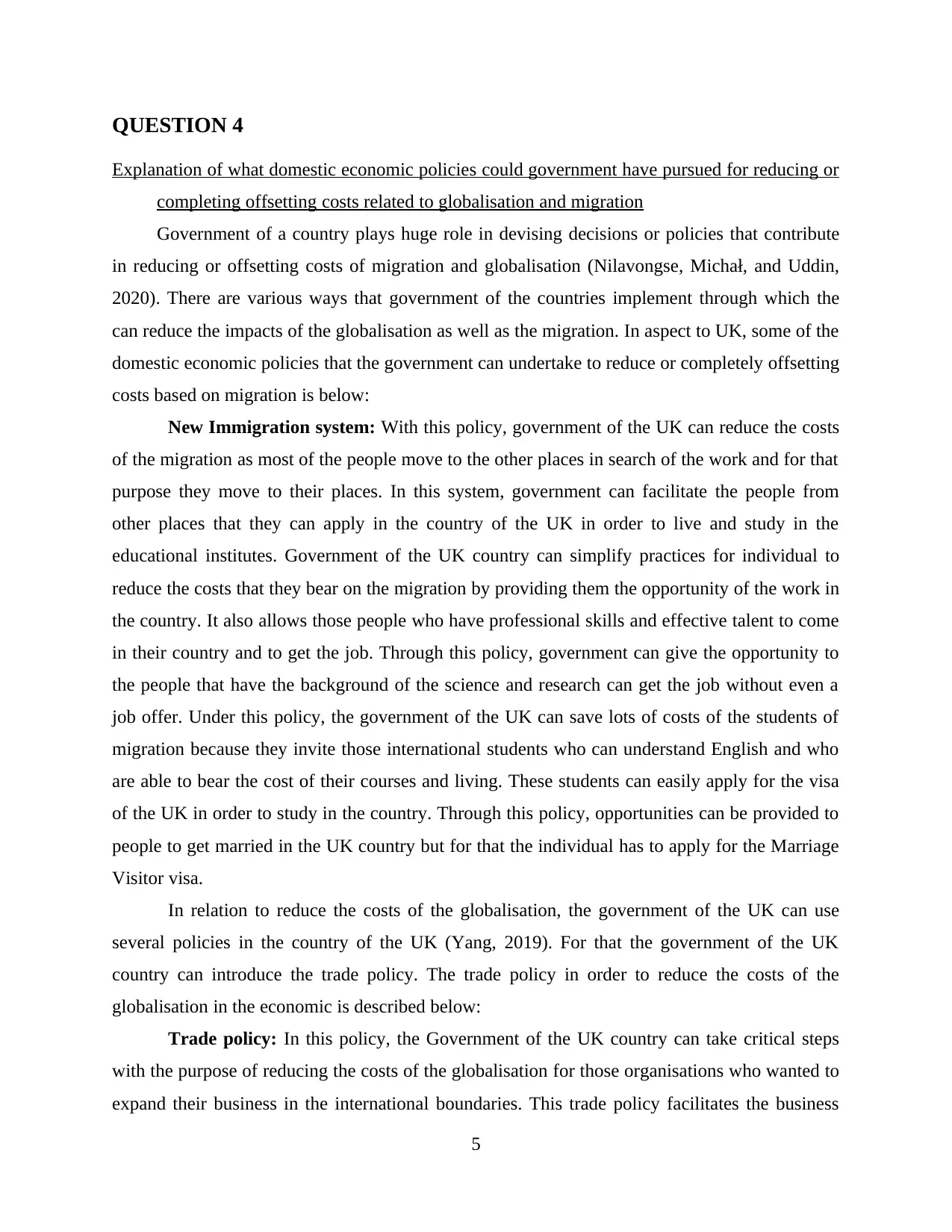
QUESTION 4
Explanation of what domestic economic policies could government have pursued for reducing or
completing offsetting costs related to globalisation and migration
Government of a country plays huge role in devising decisions or policies that contribute
in reducing or offsetting costs of migration and globalisation (Nilavongse, Michał, and Uddin,
2020). There are various ways that government of the countries implement through which the
can reduce the impacts of the globalisation as well as the migration. In aspect to UK, some of the
domestic economic policies that the government can undertake to reduce or completely offsetting
costs based on migration is below:
New Immigration system: With this policy, government of the UK can reduce the costs
of the migration as most of the people move to the other places in search of the work and for that
purpose they move to their places. In this system, government can facilitate the people from
other places that they can apply in the country of the UK in order to live and study in the
educational institutes. Government of the UK country can simplify practices for individual to
reduce the costs that they bear on the migration by providing them the opportunity of the work in
the country. It also allows those people who have professional skills and effective talent to come
in their country and to get the job. Through this policy, government can give the opportunity to
the people that have the background of the science and research can get the job without even a
job offer. Under this policy, the government of the UK can save lots of costs of the students of
migration because they invite those international students who can understand English and who
are able to bear the cost of their courses and living. These students can easily apply for the visa
of the UK in order to study in the country. Through this policy, opportunities can be provided to
people to get married in the UK country but for that the individual has to apply for the Marriage
Visitor visa.
In relation to reduce the costs of the globalisation, the government of the UK can use
several policies in the country of the UK (Yang, 2019). For that the government of the UK
country can introduce the trade policy. The trade policy in order to reduce the costs of the
globalisation in the economic is described below:
Trade policy: In this policy, the Government of the UK country can take critical steps
with the purpose of reducing the costs of the globalisation for those organisations who wanted to
expand their business in the international boundaries. This trade policy facilitates the business
5
Explanation of what domestic economic policies could government have pursued for reducing or
completing offsetting costs related to globalisation and migration
Government of a country plays huge role in devising decisions or policies that contribute
in reducing or offsetting costs of migration and globalisation (Nilavongse, Michał, and Uddin,
2020). There are various ways that government of the countries implement through which the
can reduce the impacts of the globalisation as well as the migration. In aspect to UK, some of the
domestic economic policies that the government can undertake to reduce or completely offsetting
costs based on migration is below:
New Immigration system: With this policy, government of the UK can reduce the costs
of the migration as most of the people move to the other places in search of the work and for that
purpose they move to their places. In this system, government can facilitate the people from
other places that they can apply in the country of the UK in order to live and study in the
educational institutes. Government of the UK country can simplify practices for individual to
reduce the costs that they bear on the migration by providing them the opportunity of the work in
the country. It also allows those people who have professional skills and effective talent to come
in their country and to get the job. Through this policy, government can give the opportunity to
the people that have the background of the science and research can get the job without even a
job offer. Under this policy, the government of the UK can save lots of costs of the students of
migration because they invite those international students who can understand English and who
are able to bear the cost of their courses and living. These students can easily apply for the visa
of the UK in order to study in the country. Through this policy, opportunities can be provided to
people to get married in the UK country but for that the individual has to apply for the Marriage
Visitor visa.
In relation to reduce the costs of the globalisation, the government of the UK can use
several policies in the country of the UK (Yang, 2019). For that the government of the UK
country can introduce the trade policy. The trade policy in order to reduce the costs of the
globalisation in the economic is described below:
Trade policy: In this policy, the Government of the UK country can take critical steps
with the purpose of reducing the costs of the globalisation for those organisations who wanted to
expand their business in the international boundaries. This trade policy facilitates the business
5
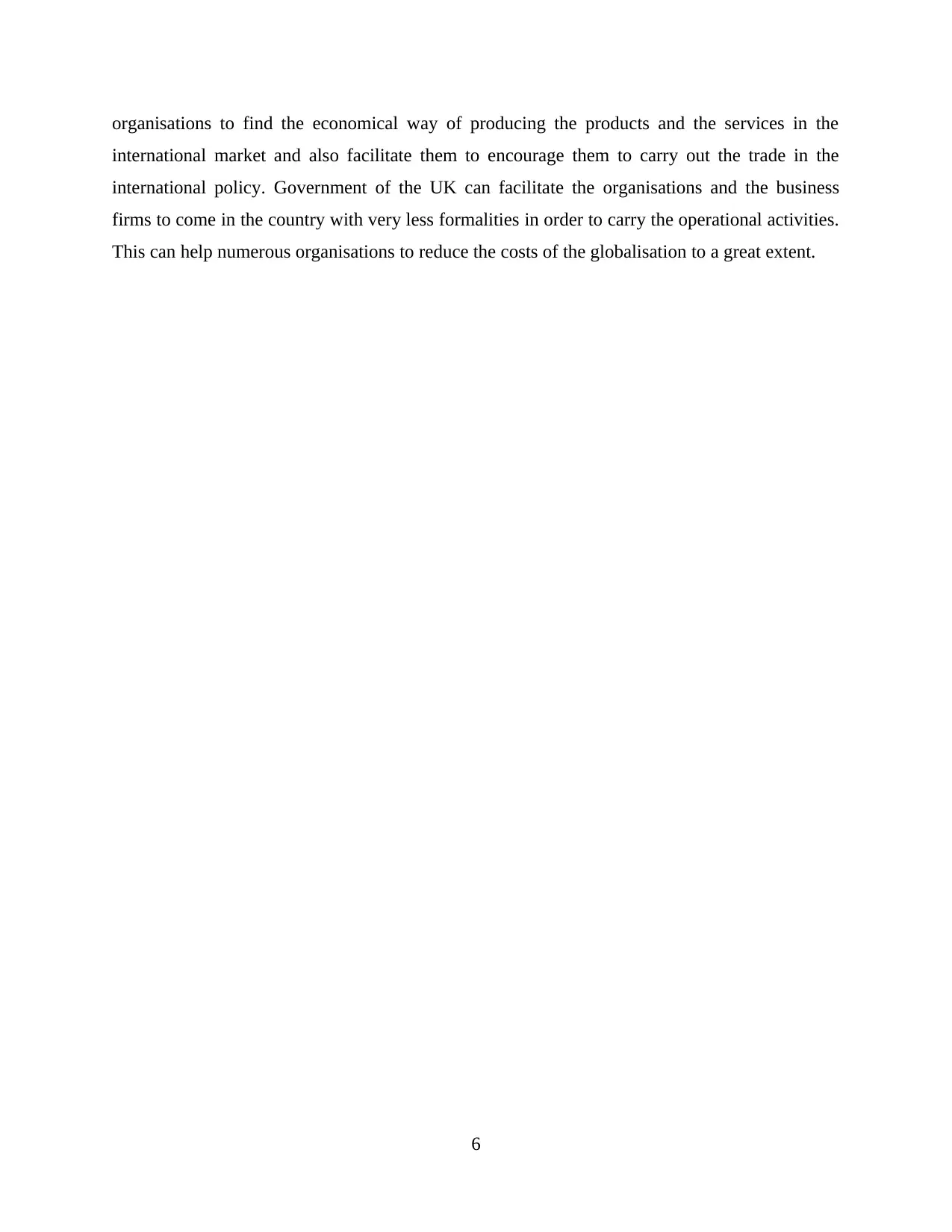
organisations to find the economical way of producing the products and the services in the
international market and also facilitate them to encourage them to carry out the trade in the
international policy. Government of the UK can facilitate the organisations and the business
firms to come in the country with very less formalities in order to carry the operational activities.
This can help numerous organisations to reduce the costs of the globalisation to a great extent.
6
international market and also facilitate them to encourage them to carry out the trade in the
international policy. Government of the UK can facilitate the organisations and the business
firms to come in the country with very less formalities in order to carry the operational activities.
This can help numerous organisations to reduce the costs of the globalisation to a great extent.
6
⊘ This is a preview!⊘
Do you want full access?
Subscribe today to unlock all pages.

Trusted by 1+ million students worldwide
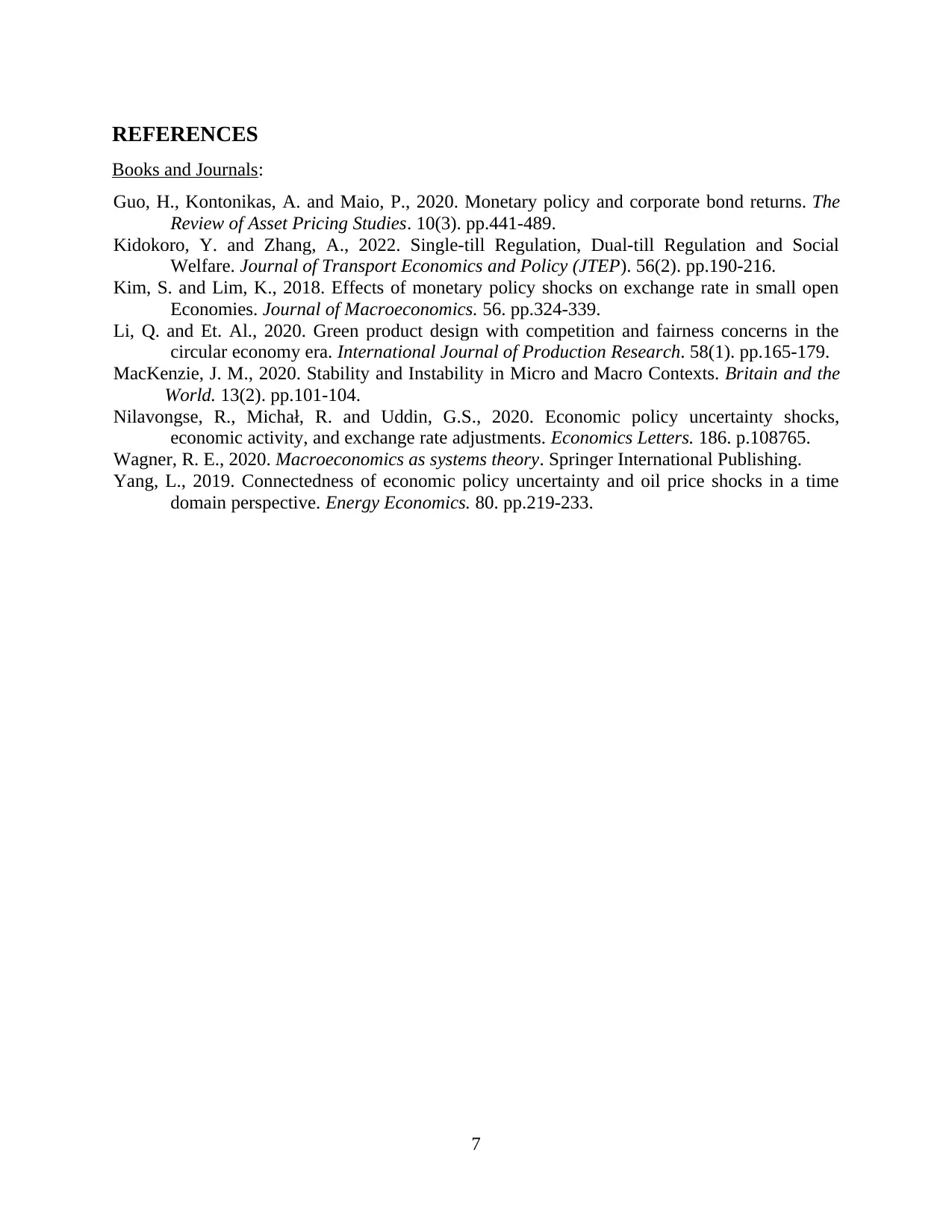
REFERENCES
Books and Journals:
Guo, H., Kontonikas, A. and Maio, P., 2020. Monetary policy and corporate bond returns. The
Review of Asset Pricing Studies. 10(3). pp.441-489.
Kidokoro, Y. and Zhang, A., 2022. Single-till Regulation, Dual-till Regulation and Social
Welfare. Journal of Transport Economics and Policy (JTEP). 56(2). pp.190-216.
Kim, S. and Lim, K., 2018. Effects of monetary policy shocks on exchange rate in small open
Economies. Journal of Macroeconomics. 56. pp.324-339.
Li, Q. and Et. Al., 2020. Green product design with competition and fairness concerns in the
circular economy era. International Journal of Production Research. 58(1). pp.165-179.
MacKenzie, J. M., 2020. Stability and Instability in Micro and Macro Contexts. Britain and the
World. 13(2). pp.101-104.
Nilavongse, R., Michał, R. and Uddin, G.S., 2020. Economic policy uncertainty shocks,
economic activity, and exchange rate adjustments. Economics Letters. 186. p.108765.
Wagner, R. E., 2020. Macroeconomics as systems theory. Springer International Publishing.
Yang, L., 2019. Connectedness of economic policy uncertainty and oil price shocks in a time
domain perspective. Energy Economics. 80. pp.219-233.
7
Books and Journals:
Guo, H., Kontonikas, A. and Maio, P., 2020. Monetary policy and corporate bond returns. The
Review of Asset Pricing Studies. 10(3). pp.441-489.
Kidokoro, Y. and Zhang, A., 2022. Single-till Regulation, Dual-till Regulation and Social
Welfare. Journal of Transport Economics and Policy (JTEP). 56(2). pp.190-216.
Kim, S. and Lim, K., 2018. Effects of monetary policy shocks on exchange rate in small open
Economies. Journal of Macroeconomics. 56. pp.324-339.
Li, Q. and Et. Al., 2020. Green product design with competition and fairness concerns in the
circular economy era. International Journal of Production Research. 58(1). pp.165-179.
MacKenzie, J. M., 2020. Stability and Instability in Micro and Macro Contexts. Britain and the
World. 13(2). pp.101-104.
Nilavongse, R., Michał, R. and Uddin, G.S., 2020. Economic policy uncertainty shocks,
economic activity, and exchange rate adjustments. Economics Letters. 186. p.108765.
Wagner, R. E., 2020. Macroeconomics as systems theory. Springer International Publishing.
Yang, L., 2019. Connectedness of economic policy uncertainty and oil price shocks in a time
domain perspective. Energy Economics. 80. pp.219-233.
7
1 out of 10
Related Documents
Your All-in-One AI-Powered Toolkit for Academic Success.
+13062052269
info@desklib.com
Available 24*7 on WhatsApp / Email
![[object Object]](/_next/static/media/star-bottom.7253800d.svg)
Unlock your academic potential
Copyright © 2020–2025 A2Z Services. All Rights Reserved. Developed and managed by ZUCOL.



